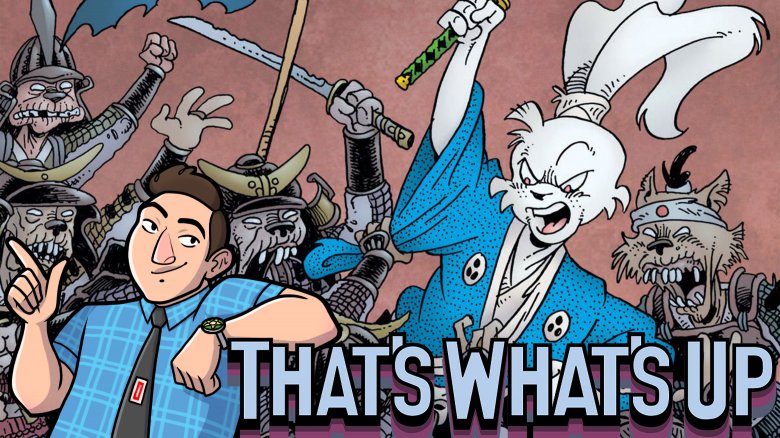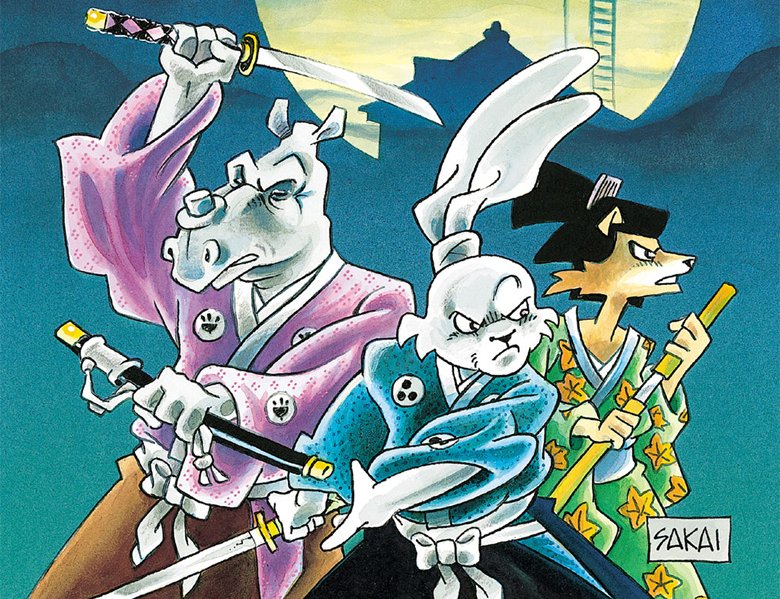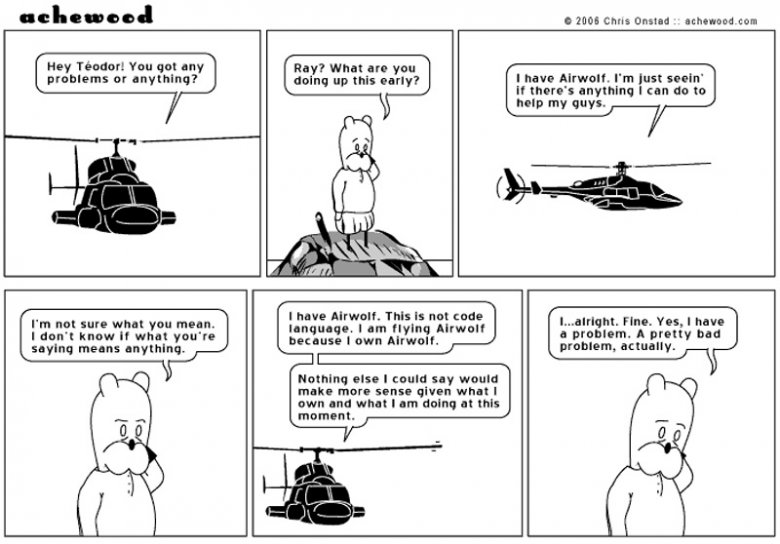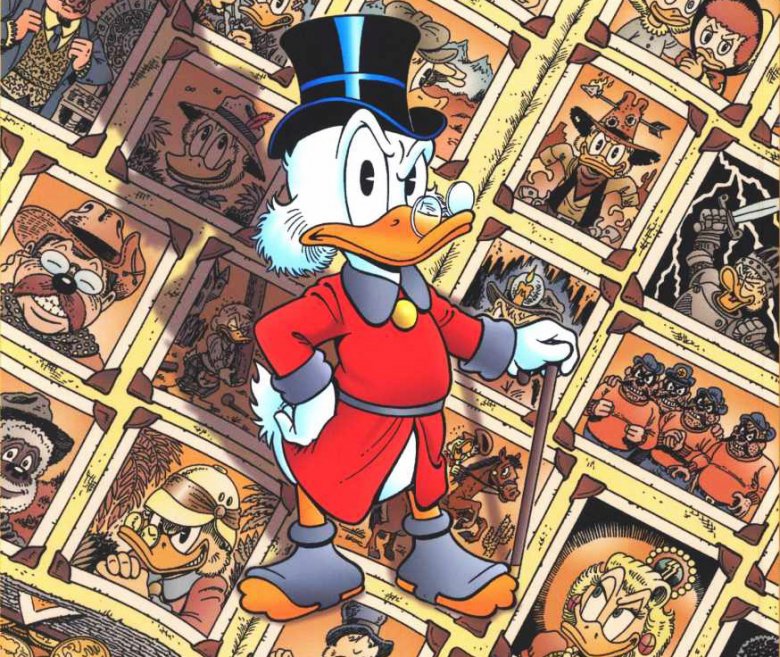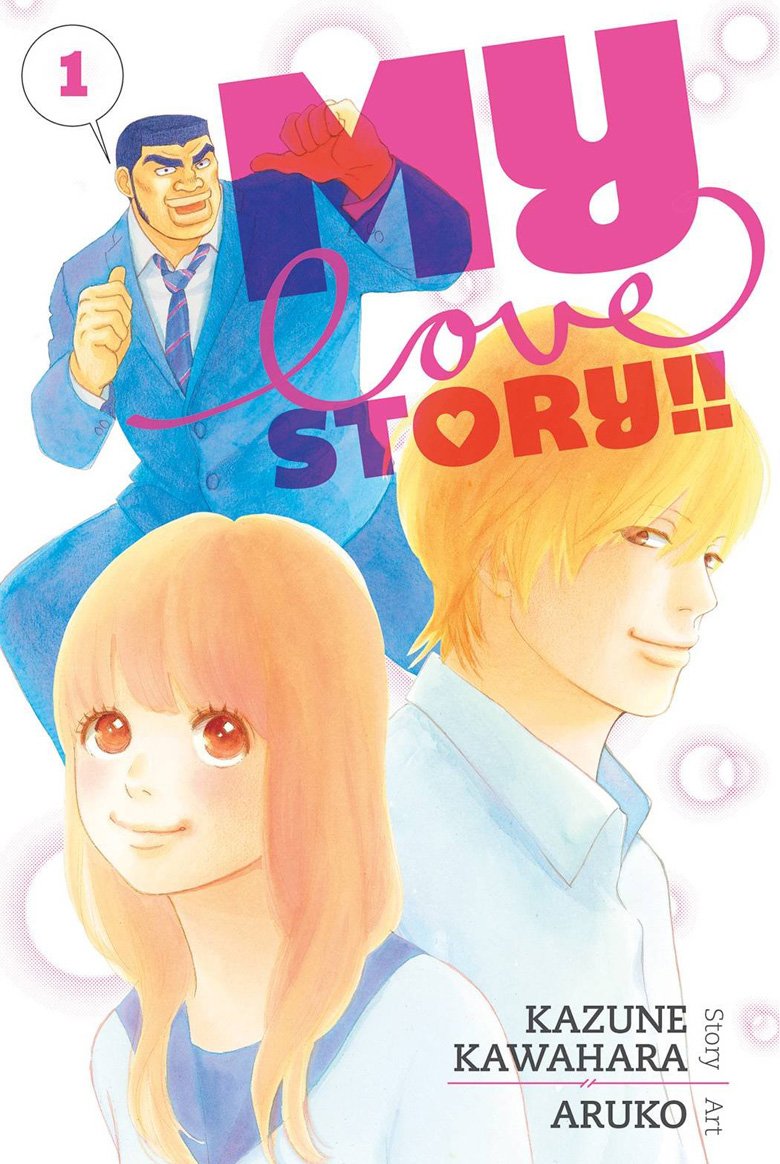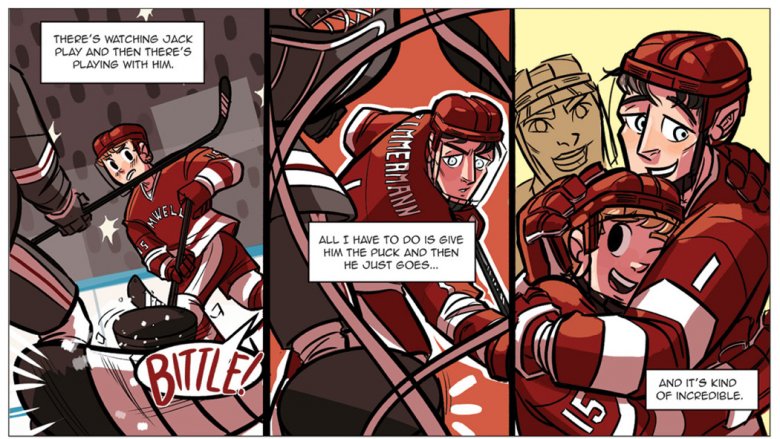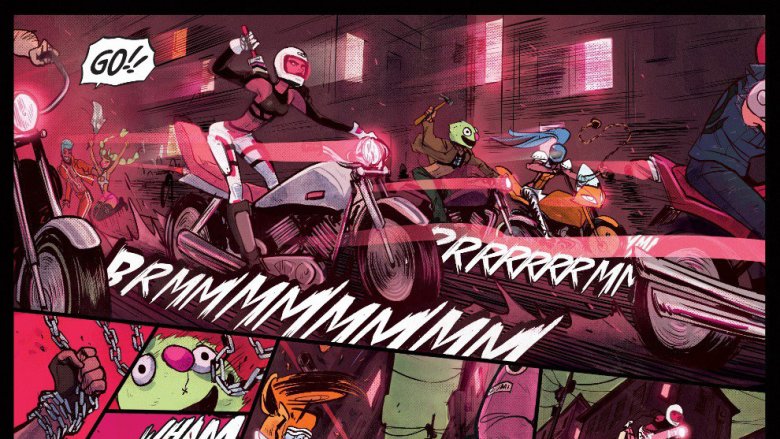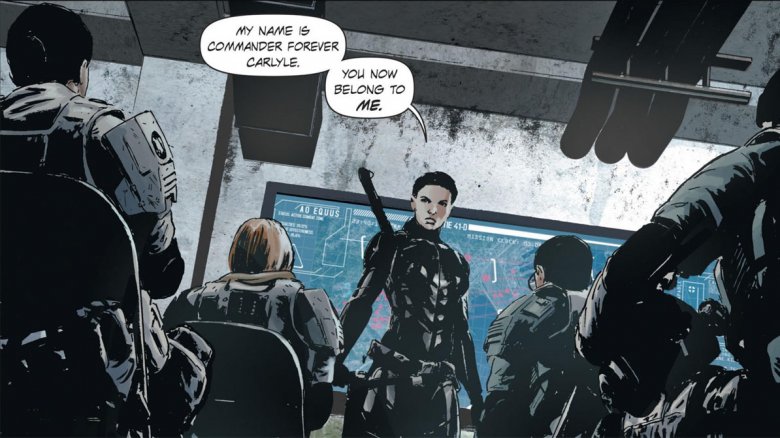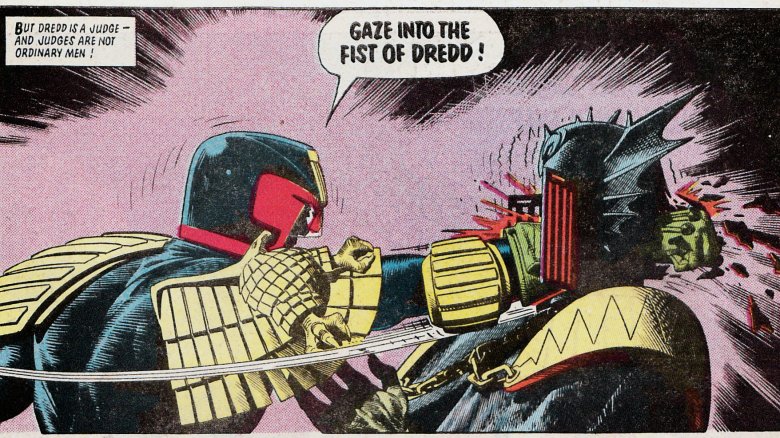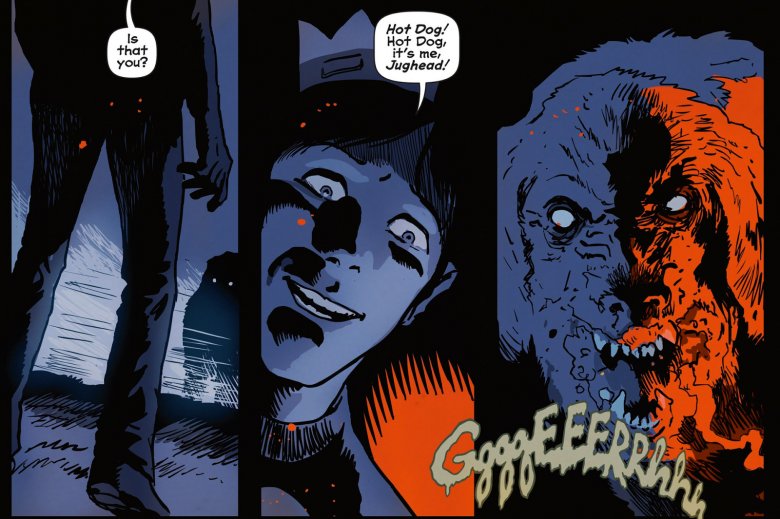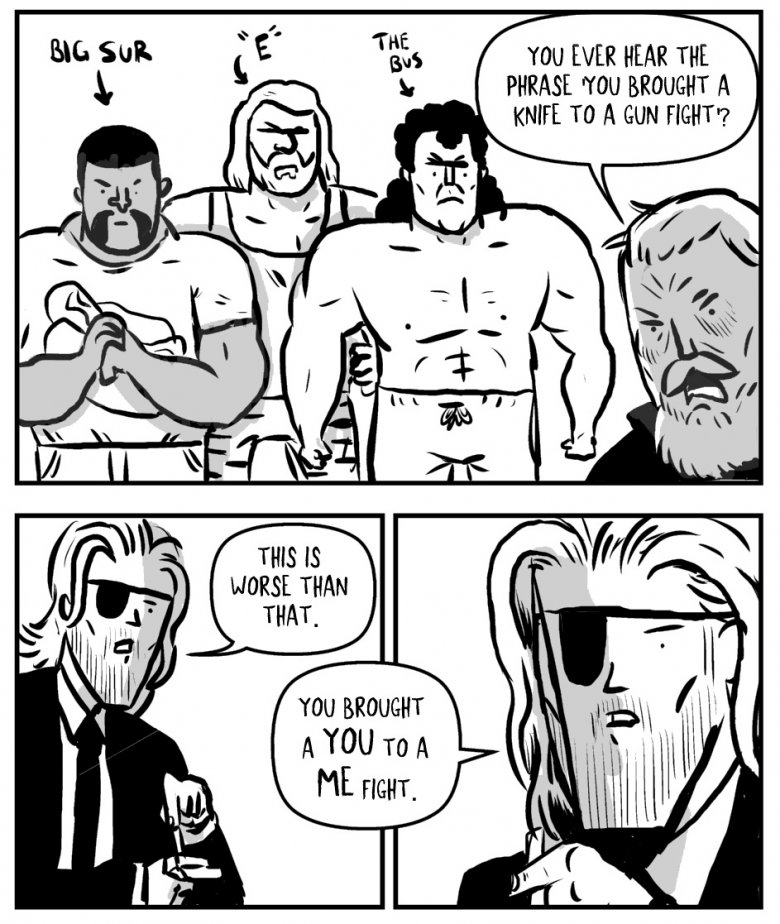That's What's Up: The Best Comics Not About Superheroes
Each week, comic book writer Chris Sims answers the burning questions you have about the world of comics and pop culture: what's up with that? If you'd like to ask Chris a question, please send it to @theisb on Twitter with the hashtag #WhatsUpChris, or email it to staff@looper.com with the subject line "That's What's Up."
Q: What're the best non-superhero comics of all time? I really want to expand my tastes but don't know where to start with all the publishers! —Cathal Donovan O' Neill (via email)
As much as I'll go to bat for the idea that comics as a medium can support just as many different kinds of stories as film or television, I have to admit that for the most part, the superhero genre is by far the one I'm most interested in. I mean, intellectually, I know that there are great stories that don't involve Batman or mutant powers, but for the most part, they're not the ones that grab me. Even the non-superhero comics that I love, like G.I. Joe or Matt Wagner's Mage, tend to at least brush up against the world of codenames and crime-fighting.
But at the same time, I've read an awful lot of comic books, and while most of them tend to involve the concept of heat vision, there are plenty that manage to get just far enough away from capes and cowls that I think they count. So if you're a superhero reader looking to expand your horizons, then here's a handful you should try out.
Usagi Yojimbo
We might as well start with arguably the single best non-superhero comic of all time: Stan Sakai's Usagi Yojimbo. And honestly? You could take "non-superhero" out of that sentence and still make a pretty good case for it. Since it debuted in 1984, Usagi's had over 200 issues written, drawn, and lettered by Sakai, and there's never been a bad one. It's at the point where the next issue could quite literally be the worst comic I'd ever read in my life, and Sakai would still average out to a better track record than anyone else in comics.
But even though it's coming up on 35 years, it's also one of the most accessible comics you're likely to find. There's a rich and well-crafted continuity there, full of recurring characters and plotlines that occasionally take years to wrap up, but those things are never an obstacle for getting into a new story. You can pick it up anywhere—Sakai even defines the word "ronin" every time it comes up, just in case you're somehow encountering the word for the very first time when it's being used to describe this particular rabbit.
Ah, right, the premise: Usagi Yojimbo stars Miyamoto Usagi, a ronin (masterless samurai) loosely based on Miyamoto Musashi, the legendary 17th century swordsman. I say "loosely" because Musashi was not, to my knowledge, a rabbit, but he did once show up to a duel without his sword and beat his opponent senseless with a wooden oar instead. Usagi wanders around a fictionalized but meticulously researched version of feudal Japan full of cartoon animals, wandering from one adventure to the next.
And it's a comic that has everything. There's obviously plenty of adventure and samurai sword-fighting, but there's also drama, romance, and one of the best incorporations of horror elements into an action story that I've ever read. I am honestly a little embarrassed at how long it took me to realize the joke of an unkillable supernatural slasher named Jei-san. If you're looking to jump on, most readers would agree that the Eisner award-winning Grasscutter, Book 12, is one of the better starting points.
Achewood
While we're on the subject of great comics about anthropomorphic animals, I'd be remiss if I didn't mention Achewood. Created in 2001 by Chris Onstad, this one started out as a sort of absurdist time-waster about what Onstad's pets and stuffed animals got up to when humans weren't around, but hit its stride a few years later when the focus shifted to the characters who would become the focus of the series for the next ten years.
Ray Smuckles and Cassandra "Roast Beef" Kazenzakis are two cats living in a sort of weird magical realism version of California that only occasionally mentions that they're not actual human beings. Ray's a ridiculously wealthy record producer with a lot of bad habits, and Beef has devastating depression to the point where even his word balloons are in a slightly smaller font with no punctuation. For the ten-year stretch between 2005 and 2015, the strip focused on their adventures and their relationship as best friends, while dropping them into bizarre situations, like Beef accidentally becoming a world-famous greeting card designer, a competitive erotica-writing contest for control of the Williams-Sonoma corporation, or Ray unlocking a secret high-roller version of eBay where he can buy Airwolf and Keith Moon's severed head.
I'll admit that the strip is weirdly difficult to get into—Onstad's unique and ultimately rewarding use of language gives Achewood's dialogue a rhythm that reads as unnatural and off-putting until it clicks and starts reshaping the way you talk to your friends. That's how it worked for me, anyway. The whole strip is available online, but do not under any circumstances start at the beginning. Instead, jump on with "The Great Outdoor Fight," one of the best comics stories of the 21st century, in which Ray and Beef get caught up in an annual no-rules brawl with 3,000 competitors and wind up exploring what it means to be friends and the challenge of living up to an absent father's legacy while also ripping off dudes' faces.
Uncle Scrooge
Okay, one last funny animal comic, and then I promise I'll talk about something with a human in it. Right now, though, we need to talk about how Scrooge McDuck is one of the greatest comic book characters of all time.
If you're only familiar with him from DuckTales, you may not be aware that the World's Richest Duck has a pretty incredible legacy. Introduced by the great Carl Barks in 1947, Scrooge brought one of the best hooks you can have in an adventure story: you can justify him going anywhere and doing anything, as long as there's money to be made. With that setup, Scrooge quickly became incredibly adaptable to different sorts of stories, and with Barks at the helm, embarked on some truly legendary adventures. There's even one story, "The Seven Cities of Cibola," that inspired the famous giant boulder sequence in the opening of Raiders of the Lost Ark.
After decades of only being known as "The Good Duck Artist"—in Barks' era, artists working on Disney comics weren't allowed to sign their work—Barks has become much more well-known. There are reprints of his work in print now identified with his name, and a lot of that is thanks largely to the work of his heir apparent, Don Rosa. Rosa is a noted fan of Barks, and pieced together offhand references to Scrooge's past to form the basis of his award-winning masterpiece, The Life & Times of Scrooge McDuck. That's a good place to start, but if you're looking for something shorter, Rosa's "A Matter of Some Gravity," in which Magica DeSpell turns Scrooge and Donald Duck's personal gravity sideways, is one of my favorite comics stories of all time.
My Love Story!!
Okay, finally, some humans! And what do humans do? They fall in love.
While mainstream American comics largely abandoned romance in favor of stories about utility belts and helicarriers, the genre has been thriving in Japanese manga for decades. I'll freely admit that I haven't read a ton, but Kazune Kawahara and Aruko's My Love Story!! is a fantastic comic by pretty much any measure. It's built around a very simple premise: the gigantic Takeo, after years of being rejected by girls he confesses his love to, falls in love with the tiny, perpetually overwhelmed Rinko after saving her from a creep on the subway. She also falls in love with him, and they begin one of the sweetest romances to ever hit the page. Complicating matters are Takeo's best friend, Sunakawa, an incredibly handsome but completely disinterested classmate who always turns down the girls who have crushes on him becasue they judge Takeo by his looks and not his heart.
In theory, My Love Story!! is so cloyingly sweet that it'll make your teeth hurt and chaste enough to be printed in a convent—there's an entire drama-filled story arc about whether Takeo and Rinko are going to hold hands for the first time—but Aruko and Kawahara pull it off so well that every piece is compelling. It's got the kind of calming, enjoyable charm that I haven't seen since I read Kiyohiko Azuma's all-too-infrequent Yotsuba&!, and believe me, that's a compliment.
Check, Please!
If the romance of My Love Story!! Is a little too heteronormative for your tastes, then there's another series I've been getting into lately that might hit the spot: Ngozi Ukazu's Check Please!
Originally published as a webcomic, Check Please tells the story of the Samwell University hockey team, and a slow burn romance between superstar player Jack Zimmerman and new recruit Eric Bittle, whose love of hockey is only matched by his love of baking pies. If you've heard of it but haven't read it, there's a reason for that: it made headlines when a Kickstarter campaign to collect the second year of the series racked up a final total of almost $400,000, over ten times the initial goal. Not bad for a series that was a combination of sports action and gay romance, two genres that most comic book publishers tend to avoid with the impression that they're not that profitable.
And when I say "slow burn," I mean it. Even reading the first year's worth of episodes all at once, Bittle and Zimmerman's interactions are mostly composed of meaningful looks and shy longing—and I mean that in a good way. In the meantime, Ukazu fills her story with fantastic drama, genuinely thrilling sports action, and some great comedic characters. If you missed the Kickstarter, don't worry. It's getting a major release from First Second later this year, and in the meantime, you can always catch up on the web.
Motor Crush
Of all the comics on this list, Motor Crush might be the easiest one for superhero readers to make the jump to. Cameron Stewart, Brenden Fletcher, and Babs Tarr were also the creative team behind the critically acclaimed 2014 relaunch and redesign of Batgirl, which dropped an updated Barbara Gordon into Gotham City's most hipster-friendly neighborhood for some great modern superhero stories.
Motor Crush was their follow-up as a team, shifting from superheroes to a sci-fi crime comic. It's essentially a noir story meets the Wachowskis' Speed Racer movie, full of glowing, hot pink drugs, deadly Mad Max-style road races, and a twist at the end of the first volume that turns the entire story into something very different than you'd expect.
Even if the story wasn't compelling, though, it would be worth checking out for the visuals alone. Tarr is a fantastic artist in her own right, but Tom Muller's design perfectly sells the book's information-overload future and the idea of Domino Swift as a reality-show celebrity who escapes from her fame by diving into a world of neon-lit crime.
Lazarus
Here's another easy sell for Batman readers: Lazarus. Writer Greg Rucka is pretty well known to superhero readers thanks to his work on Batman, Wonder Woman, Batwoman, and others. Even non-superhero readers are probably familiar with Queen & Country, the brutal spy comic he created with a variety of artists, including Steve Rolston, Carla Speed McNeil, and Mike Norton. He and artist Michael Lark also worked together previously on Gotham Central, a comic about the cops who have to deal with everything that happens in Batman's hometown, which wound up producing one of the best Joker stories ever.
Lazarus, on the other hand, is at least as good as anything Rucka and Lark have worked on before, and likely better than most of it. It's dystopian sci-fi set in a not-too-distant future when governments have fallen, replaced by Families that have taken absolute control over the world. Each family has a Lazarus, an all-but-unkillable soldier engineered with biotechnology to recover from any injury, and we follow Forever Carlyle as she navigates a world of politics and betrayal. I usually hate these kind of comparisons, but it really is like a sci-fi Game of Thrones set after a mild apocalypse.
Judge Dredd
Okay, I'll admit that I'm fudging this one just a little bit. It's more of a sci-fi dystopian adventure story than a proper superhero comic, but 2000 AD's Judge Dredd definitely has enough elements that are more than a little bit superhero-adjacent. I mean, his most famous nemesis is a genocidal interdimensional zombie version of himself, and if that's not a supehrero plot point, then friend, I don't know what is. That said, Dredd doesn't quite fit into the genre, and he's always worth mentioning, if only because he's never achieved the kind of fame in America that he has in 2000 AD's native U.K., and that's a real shame.
Dredd was created by John Wagner and Carlos Ezquerra in 1977, and unlike many other characters who went on to found an entire franchise, his creators have stayed active in shaping his character and his world ever since. Wagner in particular has been the primary architect of Dredd's stories, and while Dredd has seen plenty of other writers over the years—including major names like like Garth Ennis, Mark Millar, Grant Morrison, and Al Ewing—his ideas are still at the core of how Mega City One has progressed. Which, incidentally, it has in real time. He might have an incredibly long lifespan thanks to the Judges' genetic engineering, but Dredd's 40 years older now than he was when he first appeared, and if you read enough of those stories back to back, you can see the effects of age and change on the character and his world.
If you want to get into more recent Dredd stories, Wagner and Ezquerra reunited for a storyline called Origins in 2007 that's split between revealing Dredd's first days during the fall of the American government and the consequences that case has during his present. It's a great jumping-on point, kicking off the next decade of tightly plotted, interconnected stories that really do provide major changes for the Meg. If you want to go back further, though, 2000 AD's been better than almost any other company at keeping their back catalog in print, making it very easy to go back to pivotal stories like "Block Mania" and "The Apocalypse War." If you liked the Karl Urban movie, do not sleep on these comics.
Afterlife With Archie
I think we can all agree that one of the most interesting things to happen in comics media over the past few years was when a TV show took the wholesome, eternally teenage Archie Comics characters and dropped them into a psychosexual murder drama about maple syrup and methamphetamines. The thing is, Riverdale actually has its roots in the comics in a pretty interesting way.
After making a joke about it on a variant cover, artist Francesco Francavilla and writer Roberto Aguirre-Sacasa, also the Chief Creative Officer of Archie Comics and Riverdale's showrunner, launched Afterlife With Archie. The premise is simple: the zombie apocalypse happens, and Riverdale—and Jughead in particular—are where it starts. From there, the rest of the gang has to deal with everything you'd expect: escaping town, holing up in Veronica's fortified mansion, dealing with people trying to keep their bites secret. It all works, largely because comedy and horror are separated by the thinnest line, and the Archie characters are the kind of teenage archetypes that work equally well in both.
It's not quite the same approach as Riverdale, but both of those projects work by keeping the characters recognizable as their comic book counterparts, and just shifting the world around them into a different genre. If you've been getting a kick out of the show and want to know what it would be like if the walking dead showed up, this is the book to get. And then move on to Archie vs. Predator, which is real, and amazing.
Sexcastle
I should probably mention right at the start that Kyle Starks is a friend of mine, so take this with the requisite grain of salt. That said, the past few years have seen him becoming the greatest high-energy high-concept fight-comic auteur working in the industry. Everything he's done has been a hoot, from Kill Them All, a sort of reverse Die Hard about an assassin and a cop teaming up to fight their way through a skyscraper to take out a criminal overlord, to Rock Candy Mountain, a depression-era kung fu hobo odyssey that's basically O Brother, Where Art Thou? by way of The Raid.
They're all worth reading, but Sexcastle is the place to start. It's a tribute to '80s action movies that's legitimately better than most of the stuff it's riffing on. A retired assassin named Shane Sexcastle—a tribute to WWE's Edge, who originally wrestled under the name Sexton Hardcastle—tries to leave his life behind by becoming a small-town florist, only to run afoul of a local crime boss who's trying very hard to be Ben Gazzara in Road House and not quite making it.
This all culminates in a fight scene that lasts about 60 pages, where Shane takes on the top nine members of the Assassin's Guild and then tames a bear by giving it a very intense look. It's ridiculously fun, and as illustrated above, it's got some of the best dialogue ever seen on a comics page.
Each week, comic book writer Chris Sims answers the burning questions you have about the world of comics and pop culture: what's up with that? If you'd like to ask Chris a question, please send it to @theisb on Twitter with the hashtag #WhatsUpChris, or email it to staff@looper.com with the subject line "That's What's Up."
